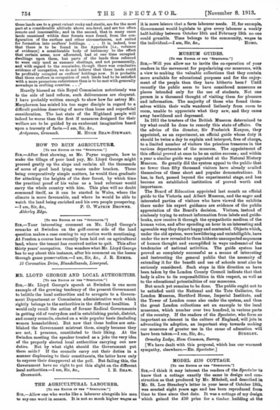MUSEUM GUIDES.
[To THE EDITOR OF THE "SPECTATOR.")
SIR,—Will you allow me to invite the co-operation of your readers in the movement for popularizing our museums, with a view to making the valuable collections that they contain more available for educational purposes and for the enjoyment of the people than they have hitherto been P Until recently the public seem to have considered museums as places intended only for the use of students. Not one person in a thousand thought of visiting them for pleasure and information. The majority of those who found themselves within their walls wandered listlessly from room to room, unable to appreciate what they saw, and they came away bewildered and depressed.
In 1911 the trustees of the British Museum determined to try what could be done to remedy this state of affairs. On the advice of the director, Sir Frederick Kenyon, they appointed, as an experiment, an official guide whose duty it should be twice a day to explain and interpret, free of charge, to a limited number of visitors the priceless treasures in the various departments of the museum. The appointment of this official proved at once to be an entire success ; and within a year a similar guide was appointed at the Natural History Museum. So greatly did the system appeal to the public that no fewer than fifty thousand visitors have already availed themselves of these short and popular demonstrations. It has, in fact, passed beyond the experimental stage, and has become an established institution of proved worth and importance.
The Board of Education appointed last month an official guide to the 'Victoria and Albert Museum, and the eager and interested parties of visitors who have viewed the exhibits there under his expert guidance are evidence of the public appreciation of the Board's decision. Visitors, instead of aimlessly trying to extract information from labels and guidebooks, now receive it through the sympathetic medium of the human voice, and after spending an hour in an interesting and agreeable way they depart happy and contented. Objects which, under the old system, were bewildering and unintelligible, have under the new revealed to them hitherto unsuspected sequences of human thought and exemplified in ways undreamt-of the tendencies of national activities. The guide system has proved so completely successful as a means of interesting and instructing the general public that the necessity of extending it for the benefit and use of schools must also be seriously considered. Such steps in this direction as have been taken by the London County Council indicate that that body is alive to its responsibilities in this respect, as well as to the educational potentialities of our museums. But much yet remains to be done. The public ought not to be satisfied until the National and the Tate Galleries, the London Museum, Hertford House, Imperial Institute, and the Tower of London come also under the system, and thus the great London collections set an example to the local museums, which number over two hundred, in various parts of the country. If the readers of the Spectator, who form so important an element in the culture of England, will join in advocating its adoption, an important step towards making our museums of greater use in the cause of education will
have been taken.—I am, Sir, &c., SITDELEY. Ormeley Lodge, Ham Common, Surrey. [We have dealt with this proposal, which has our warmest sympathy, elsewhere.—ED. Spectator.]


















































 Previous page
Previous page